Pilot Briefing: 'Ultimate paradise’
Triple Tree’s Joe Nall Week is largest RC fly-in in the world
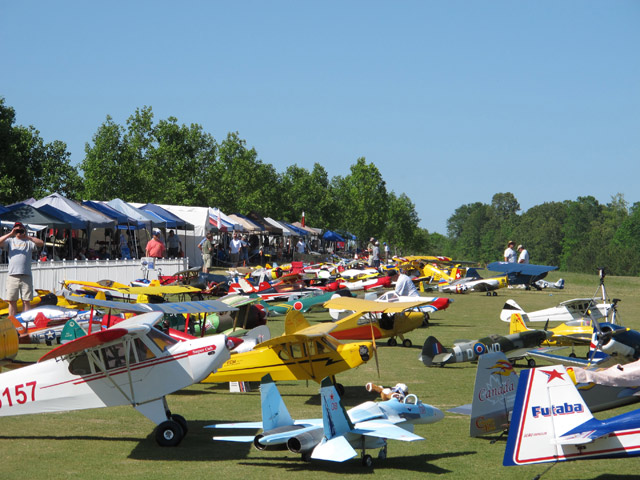
The tower is closed, and yellow Xs mark the ends of Runway 3/21, but the 7,000-foot grass strip and lake at Triple Tree Aerodrome are abuzz with helicopters, jets, aerobatic aircraft, warbirds, and floatplanes. Joe Nall Week, which ran from May 9 through 16 at the aerodrome in Woodruff, South Carolina, is the largest radio control fly-in in the world, attracting about 1,700 RC pilots from all 50 states and 11 countries—and more than 10,000 spectators.
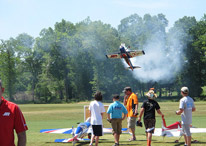 Just like at Sun ’n Fun or EAA AirVenture, spectators crane their necks skyward to watch aircraft dance through the air, whistle and applaud performances, and judge landings. The similarities between large RC aircraft and the airplanes from which they are scaled are striking. RC pilots preflight their control surfaces and hand prop their gas-engine airplanes (during hand propping, another RC pilot or crew member straddles the aircraft, his or her legs against the leading edge of the horizontal stabilizer). Landings are similar too—some come in too fast and balloon, some skip across the water, while others grease their touchdowns. Pilots of RC taildraggers also have personal preferences for three-point or wheel landings.
Just like at Sun ’n Fun or EAA AirVenture, spectators crane their necks skyward to watch aircraft dance through the air, whistle and applaud performances, and judge landings. The similarities between large RC aircraft and the airplanes from which they are scaled are striking. RC pilots preflight their control surfaces and hand prop their gas-engine airplanes (during hand propping, another RC pilot or crew member straddles the aircraft, his or her legs against the leading edge of the horizontal stabilizer). Landings are similar too—some come in too fast and balloon, some skip across the water, while others grease their touchdowns. Pilots of RC taildraggers also have personal preferences for three-point or wheel landings.
PowerBox Systems, a German team that flies two 1:6-scale Sukhoi Su–30 MKK Russian fighters and wows crowds at RC shows around the world with their formation demonstration rivaling that of full-scale jets, said Triple Tree is “the biggest show. There’s nothing we can compare it with.”
Attendees note the fellowship among pilots, on-field camping, a pristine 7,000-foot runway, and fishing and hiking trails as reasons Triple Tree is an ideal location.
“They don’t make anything better than this,” says Larry Hultman, a self-proclaimed “diehard radio control guy.” “It’s a place to start the year off every time.” Hultman, of Livingston, Texas, owns 18 RC aircraft ranging from a $400 trainer to his pride and joy, an $11,500 65-percent-scale RC Fokker DR–1 triplane with a 16-foot wingspan he claims is the largest DR–1 flying in the world. He says Triple Tree is a must. “This is just the ultimate paradise for RC pilots.”
Email [email protected]
The annual event, which kicks off the radio-control aircraft season, started in 1983 and was renamed Joe Nall Week in 1990 after Nall—an NTSB board member and personal friend of Triple Tree Aerodrome owner Pat Harness—was killed in an aircraft accident in Venezuela in 1989. Nall had served as master of ceremonies for the event from 1982 until 1989.
‘Gentlemen, it’s a pleasure’
Doolittle Tokyo Raiders receive Congressional Gold Medal
By Alyssa J. Miller
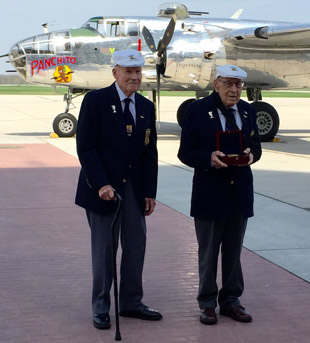 It took 72 years, 11 months, 28 days, and an act of Congress, but the Doolittle Tokyo Raiders finally received the Congressional Gold Medal for their heroic raid bombing Japan’s mainland in 1942. Of the 80 men who launched from the USS Hornet in the Pacific Ocean aboard 16 North American B–25 Mitchell bombers, only two men—Lt. Col. Richard E. Cole and Staff Sgt. David J. Thatcher—lived to see the honor. Lt. Cols. Edward J. Saylor and Robert L. Hite died earlier this year.
It took 72 years, 11 months, 28 days, and an act of Congress, but the Doolittle Tokyo Raiders finally received the Congressional Gold Medal for their heroic raid bombing Japan’s mainland in 1942. Of the 80 men who launched from the USS Hornet in the Pacific Ocean aboard 16 North American B–25 Mitchell bombers, only two men—Lt. Col. Richard E. Cole and Staff Sgt. David J. Thatcher—lived to see the honor. Lt. Cols. Edward J. Saylor and Robert L. Hite died earlier this year.
The Congressional Gold Medal was awarded April 15 during a ceremony at Emancipation Hall in the U.S. Capitol. John Hudson, director of the National Museum of the U.S. Air Force, accepted the medal on behalf of the Raiders. Cole and Thatcher did not attend the event in Washington, D.C., but did take part in a ceremony April 18—the seventy-third anniversary of the raid—at Wright-Patterson Air Force Base in Dayton, where they donated the medal to the museum.
A B–25 named Panchito delivered the medal to Wright-Patterson along with dignitaries including Don Penny Schneider, a personal friend of Jimmy Doolittle. (According to Larry Kelley, owner and pilot of Panchito, Schneider donned the watch that Doolittle’s mother-in-law had given him in 1939, which he wore on the raid and into the 1970s before giving it to Schneider.) After Panchito landed, two fire trucks arched water cannons for the B–25 to taxi through on its way to Cole and Thatcher.
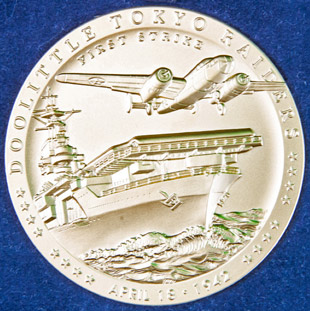
Brian “Bear” Anderson, the Doolittle Tokyo Raiders Association sergeant at arms who worked with Sen. Sherrod Brown (D-Ohio) and Rep. Pete Olson (R-Texas) to get legislation introduced to bestow the Congressional Gold Medal on the Raiders, walked from Panchito to present the medal to Cole and Thatcher. “Gentlemen, it’s a pleasure to be able to present you with this Congressional Gold Medal for the Doolittle Tokyo Raiders,” he said.
Gold Medal
The Congressional Gold Medal (left) features the first B–25 flying off the USS Hornet, with the words “First Strike.” The front of the medal includes “Doolittle Tokyo Raiders,” the date of the attack, and 16 stars that represent the number of B–25 crews that participated in the raid. The back features three B–25s; the group’s motto, “Toujours Au Danger”; patches of each of the four squadrons that participated; and an outline of Japan. “It’s beautiful,” said Lt. Col. Richard E. Cole (on left), “a good representation of the group.” Of the medal, Staff Sgt. David J. Thatcher said, “I’m glad it was for the entire crew.”
Email [email protected]
Cirrus on the move
Relocating portions of business to Tennessee
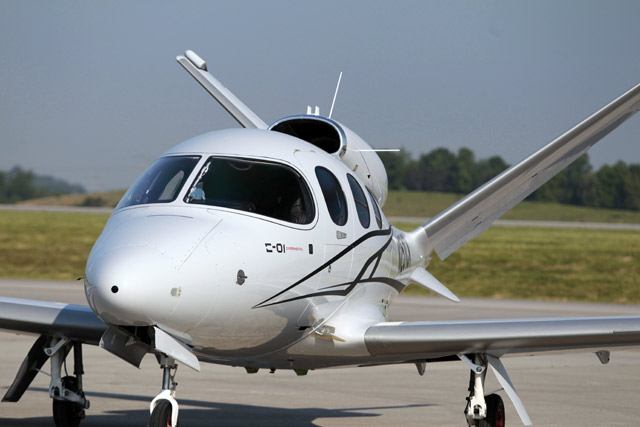
Cirrus Aircraft announced it will house all training, aircraft delivery, and service and support from a new facility at the McGhee Tyson Airport in Knoxville, Tennessee. Although the SF50 Vision Jet personal jet prompted the announcement, Cirrus also will be relocating the same customer-forward business units for the SR20 and SR22 to Knoxville as well. When complete, the facility will be “well north of 175,000 square feet,” according to Cirrus’ Ben Kowalski. The two-year goal is to employ 170 people and bring $15 million in economic impact to the region. Some of those 170 will include senior staff, such as executive vice president Todd Simmons.
Type rating training will be factory direct and take place in a Level D simulator that’s currently being built by CAE. Kowalski said one of the things that drew the company to the area was weather and convenience. From the new campus students will be able to walk to the hotel and airline terminal. The company’s new personalization team also is relocating to Knoxville. The premium service gives customers the option to choose unique interior materials and designs, to name a few. It’s proven popular for the SR22, and will no doubt be in even more demand for the more than 500 jet position holders.
Local and state officials attended the announcement. Among them was Tennessee Gov. Bill Haslam, who said that construction will begin in two months and be completed in 2016. Randy Boyd, the commissioner of the Tennessee Department of Economic and Community Development, stressed that they don’t simply throw money to draw business, instead preferring to think in terms of partnerships. Kowalski calls the agreement to bring Cirrus to Knoxville a “public, private partnership.”
Cirrus Aircraft CEO Dale Klapmeier said the people were one of the key reasons for choosing Knoxville. He called the announcement a transformational day for Cirrus. “We delivered 6,000 airplanes from Duluth and we’ll deliver the next 6,000 from here,” he said.
New pilot wins Sporty’s RV-12
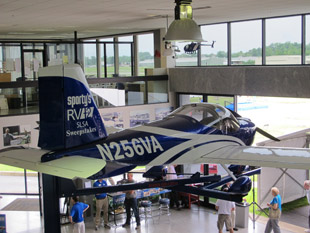 Two years ago, Rick Okikawa turned to Sporty’s during his quest to become a private pilot—he purchased the company’s Learn to Fly course for his ground study. In 2014, he earned his private pilot certificate and more recently turned to Sporty’s once again to purchase supplies for his flying needs. He bought a ForeFlight subscription in April, which entered him for a chance to win the 2015 Sporty’s RV–12 Sweepstakes Light Sport aircraft.
Two years ago, Rick Okikawa turned to Sporty’s during his quest to become a private pilot—he purchased the company’s Learn to Fly course for his ground study. In 2014, he earned his private pilot certificate and more recently turned to Sporty’s once again to purchase supplies for his flying needs. He bought a ForeFlight subscription in April, which entered him for a chance to win the 2015 Sporty’s RV–12 Sweepstakes Light Sport aircraft.
Sporty’s President Michael Wolf called Okikawa May 16 during the annual Sporty’s Fly-In and Open House to let him know he had won the aircraft. Broadcasting the call through a sound system for fly-in attendees to listen in on the surprise, Wolf spoke to Okikawa about his purchases and listened as the private pilot talked about using ForeFlight and flying Cessna 172s.
“Now you can fly your brand-new RV–12,” Wolf said.
In disbelief, Okikawa started laughing. “This is kind of surreal,” he responded after a few moments. Wolf assured Okikawa that he had won the Van’s Aircraft RV–12 and joked that if he needed more proof, he could call the Sporty’s hotline to ask their customer service representatives for verification.
“I’ll be pinching myself, making sure I’m awake,” Okikawa continued.
“You’re a new pilot and now you have a new airplane to go along with it,” Wolf said, explaining to Okikawa that Sporty’s would work out the details for him to pick up the RV–12 and fly it back to California where he lives.
Sporty’s next sweepstakes airplane is a Legend Cub Light Sport aircraft valued at approximately $130,000. To enter, place an order with Sporty’s or request a catalog before 5 p.m. Eastern Daylight Time on May 12, 2017. —Alyssa J. Miller
First Air Force One to be restored
A deal that could return an early Air Force One—possibly the first airplane to fly with that call sign—to the sky has taken a step forward.
Dynamic Aviation of Bridgewater, Virginia, will purchase Columbine II, which flew President Dwight D. Eisenhower. The Lockheed Constellation was the primary presidential aircraft from 1952 (when Eisenhower, then president-elect, made a top secret flight to Korea) until 1954, when it was replaced by a Super Constellation, although it remained in service as a backup for presidential transport.
Karl D. Stoltzfus Sr., founder of Dynamic Aviation, said that inspection and repairs have been completed satisfactorily.
Columbine II was retired from government service in 1968 and sold as surplus government property. Christler Flying Service purchased several of the aircraft and used Columbine II for spare parts, supporting a small fleet of Constellations used for pest control and other missions.
Alerted by the Smithsonian National Air & Space Museum in 1980 that the Christler “spares” airplane had a presidential history, the family began restoring it. Harry Oliver, a current co-owner, joined them in 1989 and Columbine II was airworthy in time to fly to events commemorating Eisenhower’s 100th birthday in 1990.
Stoltzfus wants to preserve Columbine II as a tribute to the nation’s leaders of the era. It will be flown to Virginia for further restoration and to join the airshow circuit—and possibly to anniversary celebrations commemorating events of the 1940s and 1950s.
Swiss firm offering Risen aircraft
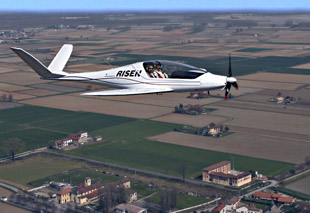 American Light Sport pilots may wish they were certificated in Europe, or decide to move there. Pilots there with the recreational and sport flying certificate may now buy a $215,000, two-seat airplane by Swiss Excellence Airplanes called Risen, which is in production and cruises at 160 knots. American Light Sport pilots are limited to 120 knots.
American Light Sport pilots may wish they were certificated in Europe, or decide to move there. Pilots there with the recreational and sport flying certificate may now buy a $215,000, two-seat airplane by Swiss Excellence Airplanes called Risen, which is in production and cruises at 160 knots. American Light Sport pilots are limited to 120 knots.
It has a variable-pitch propeller, electrically operated canopy, and retractable landing gear. It was first reported on the ByDanJohnson.com website during the Aero Friedrichshafen airshow in Germany. While the company is Swiss, the aircraft was designed by engineer Alberto Porto who is both Italian and Argentinean.
The carbon fiber airplane is certified based on JAR-VLA regulations, which stands for Joint Aviation Requirements for Very Light Aeroplanes. It is claimed to fly 800 nautical miles on 22 gallons of fuel, using a 100-horsepower Rotax 912 engine. Its stall speed is 30 knots. It can take off in 660 feet.
Intended as a luxury ultralight, it features an airframe parachute, Bose communication components, leather seats, and an autopilot as standard equipment. Electric flaps and trim complete the luxury features. The company, based in Lugano, Switzerland, promises that if the engine is operated at 50-percent power, the range can be extended to 1,000 nautical miles.
—AKM
AOPA launches flight training poll, sweepstakes
AOPA has opened its popular flight training poll, a survey that allows student pilots at all levels to share feedback on their flight training experiences (http://flighttraining.aopa.org/poll/).
Survey results are used to determine AOPA’s annual Flight Training Excellence Awards. This is the fourth year for the poll, which provides valuable data on the performance—good and bad—of flight schools and instructors as a means of encouraging the adoption of best practices and improving the customer experience.
In 2015, AOPA is introducing a sweepstakes that offers valuable prizes to poll participants. Generous donations from Jeppesen, Sporty’s, and David Clark will allow participants a chance to win one of the following valuable prizes: Jeppesen Part 141 Private Pilot Kit, David Clark H10-13.4 Aviation Headset, Sporty’s Flight Gear iPad Bag
The poll is based on AOPA’s extensive research into the optimal flight training experience and focuses on educational quality, customer focus, community, and information sharing. Participants can sign on to an AOPA Web page to answer 39 questions on flight schools and 27 questions on flight instructors.
The poll will close at midnight on August 22. Participants do not have to be AOPA members.
“AOPA’s flight training poll has become an invaluable tool for flight schools and instructors who want to measure their effectiveness and adopt the practices that fit them best,” said Chris Moser, AOPA’s program manager of flight training initiatives. “The poll results also allow us to publicly recognize those in flight training who are preparing lifelong, passionate aviators.”
Data collected from the poll will be compiled and shared as an overall report through Flight Training magazine in early 2016. Individual flight instructors may obtain personalized reports on poll results by Emailing a request to [email protected].
This month in aviation
July 2, 1900. First flight of the Zeppelin rigid airship.
July 4, 1908. Glenn Curtiss flies the June Bug more than a mile.
July 25, 1909. Louis Bleriot crosses the English Channel in his Bleriot.
July 14-15, 1919. The Vickers Vimy flies nonstop across the Atlantic Ocean.
July 15-22, 1933. Wiley Post flies his Lockheed Vega, Winnie Mae, solo around the world.
July 28, 1935. The B–17 Flying Fortress is unveiled.
July 2, 1937. Amelia Earhart is lost en route to Howland Island from Lae, New Guinea.
July 1, 1941. Jacqueline Cochran is the first woman to ferry a bomber across the Atlantic as part of “Wings for Britain.”
July 19, 1941. The Tuskegee Airmen, the first black fighter pilot squadron, is formed.
July 20, 1969. Apollo 11 lands on the moon. Neil Armstrong and Buzz Aldrin are the first to make the giant leaps.
July 20, 1976. Viking I is the first U.S. spacecraft to land on another planet—Mars.
July 22-27, 1999. Eileen Collins is the first woman to command a U.S. space mission.
July 2, 2002. Steve Fossett completes circumnavigation of the globe in his balloon, Spirit of Freedom.
July 6, 2013. Solar Impulse completes its first cross-country flight.
Sponsored by Breitling
NOTICE OF ANNUAL MEETING OF MEMBERS
The annual meeting of the Members of the Aircraft Owners and Pilots Association will be held at 12 noon on Friday, September 11, 2015, at the headquarters of AOPA, 421 Aviation Way, Frederick, Maryland, 21701, located on the Frederick Municipal Airport (FDK), for the purpose of receiving reports and transacting such other business as may properly come before the meeting, specifically including the election of trustees.
If you are not able to attend but would like to appoint your voting proxy, please visit the website or call 800-872-2672.
—Kenneth M. Mead, Secretary


